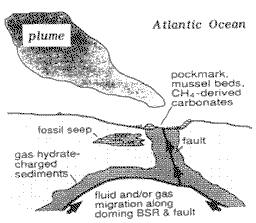 |
Science Frontiers ONLINE No. 100: Jul-Aug 1995 |
|
|
Giant sea-bed pockmarks
[The following long, initially dull (?) discussion leads unerringly to the Bermuda Triangle via a Fortean phenomenon!]
Unrecognized until just a few years ago (SF#100*), sea-bed pockmarks are remarkable geological features. They occur worldwide on the floors of all of the oceans and even some lakes. They are found in shallow waters and at depths of thousands of meters. In diameter, these roughly conical depressions may span 350 meters or more and be up to 35 meters deep. No trivial phenomenon, some pockmark fields exceed 1,000 km2. Like the curious abyssal ridges (SF#97), sea-bed pockmarks are rarely discussed despite their great geological and economic importance.
Recent issues of Geology contain three fascinating papers relating to giant sea-bed pockmarks. In Ref. 1, J.T. Kelley et al describe a pockmark field in Belfast Bay, Maine. Here, the density of the pockmarks reaches 160 per km2, and they are apparently the largest pockmarks yet discovered. The Belfast Bay field is "fresh" and "active" in the sense that the pockmarks are sharply defined and methane bubbles still stream up from buried organic matter.
 Natural-gas plume rising from the sea-floor off the Carolina coast. |
Lastly, in Ref. 3, C.K. Paull et al report on the release of plumes of methane bubbles from the Carolina continental rise at a depth of 2167 meters. Here, the sediments are riddled with methane hydrate.
Why all this fuss over fizzy ice, and what is the connection between methane hydrate and pockmarks?
- The methane hydrate deposits represent immense accumulations of methane -- probably far more natural gas than geologists have found on the continents.
- Sea-bed pockmarks are thought to be formed when methane gas is explosively vented, perhaps when methane hydrate -- very unstable stuff -- suddenly decomposes.
- Offshore booms and mistpouffers (SF#73*) are often heard in the areas where pockmarks are common.
- Rich clusters of methane-dependent life forms surround methane seeps.
- The quantity of buried organic matter required to create all the offshore methane is staggering. Where did it all come from and how did it come to be buried at such great depths? Could some of the offshore methane be abiogenic?
- (6) Could the explosive decomposition of methane hydrate create giant bubble plumes that might engulf ships (in certain infamous "triangles") and cause them to sink like rocks in the low-density froth? (SF#25*)
References
Ref. 1. Kelley, Joseph T., et al; "Giant Sea-Bed Pockmarks: Evidence for Gas Escape from Belfast Bay, Maine," Geology, 22:59, 1994.
Ref. 2. Vogt, Peter R., et al; "Methane-Generated (?) Pockmarks on Young, Thickly Sedimented Oceanic Crust in the Arctic: Vestnesa Ridge, Fram Strait," Geology, 22:255, 1994.~
Ref. 3. Paull, Charles K., et al; "Methane-Rich Plumes on the Carolina Continental Rise: Association with Gas Hydrates," Geology, 23:89, 1995.
SF#xx = Science Frontiers #xx. SF#25 and SF#73 are also printed in the book Science Frontiers. To order, see here.